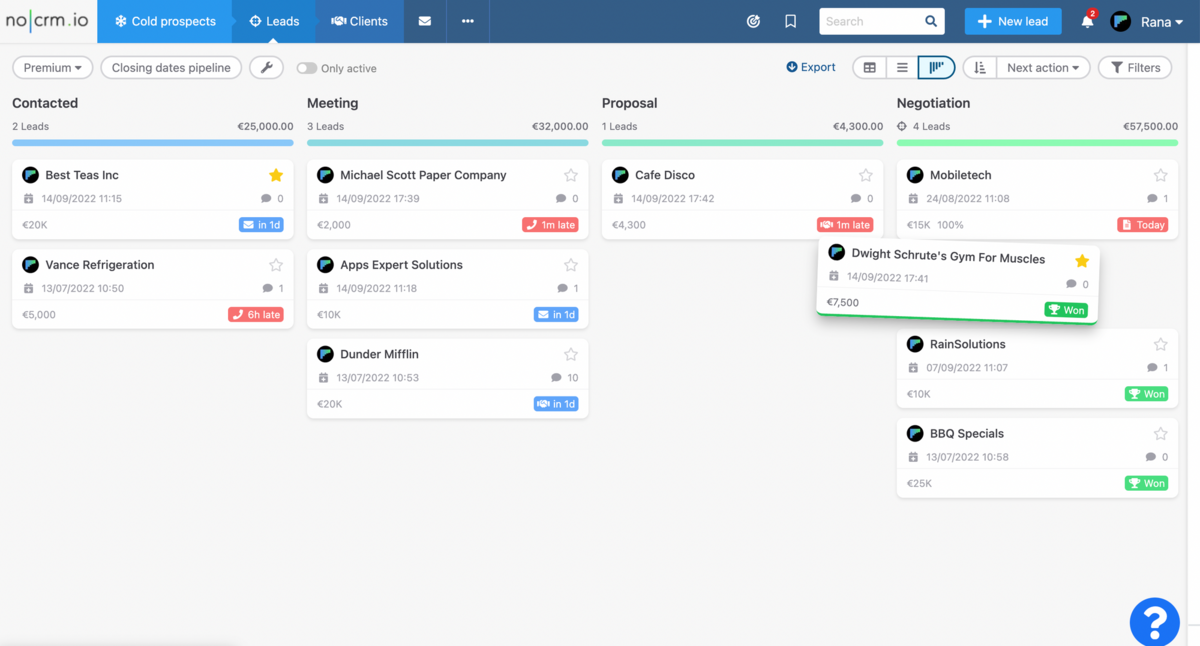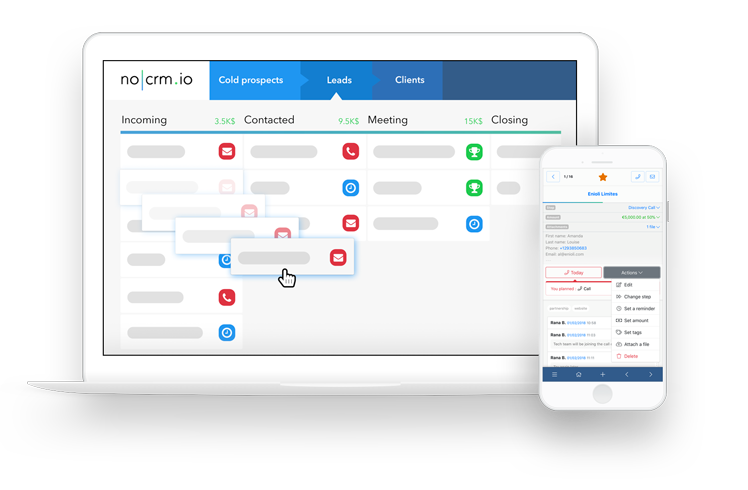How to Develop the Right Sales Process to Close your Deals
After the webinar on how to generate prospects on LinkedIn, noCRM and Waalaxy, continue giving advice on the next step towards successful deals: converting prospects into actual clients.
Watch the webinar right here:
A guide to the sales process
What is a sales process?
A sales process, combining marketing and commercial efforts, is the entirety of a sale, from first contact to the closing of a deal. The sales process begins with the marketing team, charged with generating leads so that the commercial team can close the sale.
Generating leads starts by choosing a list of prospects, which are potential individuals that will be contacted by the sales team. These prospects are sent to the commercial team, who will establish first contact, if this has not already been made automatically. The commercial team is charged with evaluating and following the prospect until the closing of the deal.
The sales process is split up into 7 steps:
- First contact
- Prospect evaluation
- Understand the needs of your prospect
- Always personalise the interaction with the prospect
- Keep a close eye on the sales pipeline
- Always think about the next step
- Automating the sales process
The first contact
The first webinar explained how to target prospects on LinkedIn and how to establish contact. The next step is how to transform the prospect’s first reply into an actual commercial conversation.
The most important, from the beginning, is to start a conversation centred around the needs of the prospect.
It’s fundamental to listen to your prospect, so as to understand their potential frustrations and to determine where they are in their customer journey. With an open approach, you will be able to evaluate your prospects early in the sales process. This will enable you to create strong, meaningful relationships, which will help strengthen your sales network.
Prospect evaluation
Although it’s often underestimated, prospect evaluation is the most important step in the process. Commercial teams tend to push their products on prospects, without checking beforehand that the potential customer is the right fit for their product.
During this step, there are multiple fundamental questions to ask yourself:
- Who am I talking to?
- What is my prospect’s job?
- Does my prospect have the power to make a decision?
- Have I identified their need?
- Do they have a project?
- Do they have a budget?
Only if all these points are checked should you set up a meeting.
To help you, noCRM has created a free sales script generator, which is compatible with all CRMs. Bear in mind that you should keep a consistent approach within your commercial team when speaking to prospects, so as to ensure a coherent and personalised interaction with your prospects.
Understanding the needs of your prospect
A commercial conversation is not a battle, it’s an exchange. At the start of the process, you should be listening to the prospect and understanding their needs, to spark their interest and discern potential issues they may have.
Each phone call should be aimed at gleaning new information or confirming existing information, such as their job or ongoing projects. Very importantly, you are not yet selling the product, you are trying to uncover your prospect’s potential obstacles.
It’s a bad sign if your prospect does not raise any objections, as it may mean that they are not interested.
Once you have identified the prospect’s objections, you can move on to the next step in the process.
Always personalise the interaction with your prospect
It is very important to guide conversations with the prospect; a common mistake is to try to answer all the prospect’s questions. Avoid this, as you are not in customer service. A commercial conversation should be used to find the fundamental needs and major objections of a prospect.
If the prospect brings up the price, it’s best to speak about the advantages of your product and return to the investment that your product represents.
Keep a close eye on the sales pipeline: the Kanban method
It’s essential to have a clear overview of ongoing sales, so that you can quickly identify the status of each active sale. This will enable you to better determine which sales are a priority, and will help you anticipate upcoming steps. To help you, noCRM offers a Kanban overview of your sales, from the prospects that are not invested to the sales you have just closed during the week. Thus, at the beginning of each day, you know who to contact, who to call. The Kanban overview will also help your team collaborate.
Make sure that your team is properly informed about the ongoing sales in the pipeline. It’s very easy to create an opportunity on noCRM — you only need a name and a phone number — making it vital that all teams members are up to date with the opportunities. Remember, you want to keep a consistent approach with the prospects.

Always think about the next step
noCRM encourages commercial teams to always put a reminder in place, to set up a next interaction with a prospect. This method should continue until a sale has been closed, or a prospect has been lost. It’s a salesperson utmost priority to chase up prospects. A lot of companies lose out on business because they forget to get back to their prospects, even though contact has been established.
noCRM makes the sales team systematically set up a reminder for the next step in the sales process with a prospect. In noCRM’s system, a lead will need to be dealt with within a clear deadline. A prospect will thus either have a TO DO or STANDBY status. The cycle of TO/STANDBY will continue until a sale has been closed or the client has been lost.
Automating the sales process
Creating templates is a great way to save time, but make sure that automation is paired with a personalised approach from your team. It’s best to use incomplete templates that your team can fill out, so as to keep a human touch to your first contact.
Ensuring a successful sales process thanks to commercial actions
What is a commercial action?
A commercial action is an action undergone by a commercial agent during the sales process. This can be a phone call, an email, or a LinkedIn exchange, for example.
It’s fundamental to split up your actions and be properly informed about them, as it will help you build and organise your commercial prospect.
The aims of the commercial team
The commercial team shouldn’t be solely invested in annual turnover, it should determine how many steps are needed for each commercial action, so as to split them up efficiently.
The manager will be tasked with evaluating the commercial team, with a larger focus than just turnover.
Closing the deal
Finding the right rhythm
Closing a deal is all about timing: make sure you don’t try to close too quickly. After identifying the prospect’s objections, create a valuable proposition with the prospect. Make sure to also not move too slowly, as you do not want to waste the prospect’s time.
There’s no need to worry, however, as the noCRM pipeline is designed to help the sale move along fluidly.
What is stopping you from closing the deal?
Competition?
Avoid undermining your competition, look to reposition them within the marker. For example, noCRM is SalesForce’s competitor, which requires a dedicated budget for personalisation. noCRM, on the other hand, is very simple to set up.
Fear of change?
If your prospect seems wary of change, focus on the advantages your product will offer them in the future.
It’s essential to minimise risks: let them know that in the worst case, their decision won’t be a failure, it’ll be part of a learning curve.
You should also make sure to know how to respond to objections regarding your product’s price.
Underline the value of your product, and bear in mind that the best price is that which is just a bit too expensive. A good salesperson is able to sell a slightly expensive price to their client.
A psychological approach to closing
A prospect will always have apprehensions before buying. Make sure you make them comfortable, and never contradict yourself. If the prospect continues to object, stress the points you agree on, to then move on to the disagreement. This will help the prospect answer their own questions.
You have to be able to deescalate a situation: there is no perfect product, just products that are able to serve a need efficiently.
You can, at times, offer a discount. Bear in mind, however, that the prospect needs to feel that this is a one-off.
Some tips for a successful sales process
Be wary of advice
Make sure that advice you receive is suited to your case. A one-off sale, for example, is very different to a subscription service. Also, advice is dependent on budget — a £400 sale requires a different approach to a £25,000 sale.
Every step counts
You only need one unsuccessful step to lose your prospect.
No process will start out perfect, the goal is to improve each step in order to find the perfect fit for your potential clients. Once you have the ideal process, you will need to adapt to the ever-changing market.
Use AB testing
At noCRM, in order to determine if an aggressive sales approach is best, the sales team will split prospects into two groups. The first group will be actively contacted via email and phone, the second will not be contacted until they reach out to noCRM themselves.
After testing, we found that there was no difference between the two groups in terms of success. Thanks to the test, we no longer waste our time by chasing down potential clients, and are now fully available when they need us.
Pros and cons of a sales process
A sales process enables you to close many deals quickly. It is also easy to replicate.
A sales process also gives a useful framework for your sales team, making their job easier. It’s especially useful for new recruits, who might not know the product as well.
Avoid, however, developing a sales process that’s too rigid, as each step will stop making sense to your sales team. Finally, it’s essential to keep a human and personalised touch to each step.
To conclude, the most vital step is to properly assess your prospect after the first contact. Make sure you are speaking to the right person and never forget to listen to them.
Their needs should be at the forefront of the sale. If you follow these steps, closing a deal shouldn’t be an issue!
